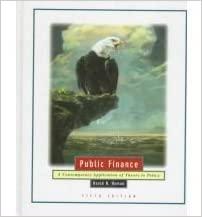Answered step by step
Verified Expert Solution
Question
1 Approved Answer
The Campbell Company is considering adding a robotic paint sprayer to its production line. The sprayer's base price is $ 8 0 0 , 0
The Campbell Company is considering adding a robotic paint sprayer to its production line. The sprayer's base price is $ and it would cost another $ to install it The machine falls into the MACRS year class the applicable MACRS depreciation rates are and and it would be sold after years for $ The machine would require an increase in net working capital inventory of $ The sprayer would not change revenues, but it is expected to save the firm $ per year in beforetax operating costs, mainly labor. Campbell's marginal tax rate is
What is the Year net cash flow?
$
What are the net operating cash flows in Years and Do not round intermediate calculations. Round your answers to the nearest dollar.
Year $
Year $
Year $
What is the additional Year cash flow ie the aftertax salvage and the return of working capital Do not round intermediate calculations. Round your answer to the nearest dollar.
$
If the project's cost of capital is what is the NPV of the project? Do not round intermediate calculations. Round your answer to the nearest dollar.
$
Should the machine be purchased?Problem
NewProject Analysis
The Campbell Company is considering adding a robotic paint sprayer to its production line. The
sprayer's base price is $ and it would cost another $ to install it The machine
falls into the MACRS year class the applicable MACRS depreciation rates are
and and it would be sold after years for $ The machine
would require an increase in net working capital inventory of $ The sprayer would not
change revenues, but it is expected to save the firm $ per year in beforetax operating
costs, mainly labor. Campbell's marginal tax rate is
a What is the Year net cash flow?
$
b What are the net operating cash flows in Years and Do not round intermediate
calculations. Round your answers to the nearest dollar.
c What is the additional Year cash flow ie the aftertax salvage and the return of working
capital Do not round intermediate calculations. Round your answer to the nearest dollar.
$
d If the project's cost of capital is what is the NPV of the project? Do not round
intermediate calculations. Round your answer to the nearest dollar.
$
Should the machine be purchased?

Step by Step Solution
There are 3 Steps involved in it
Step: 1

Get Instant Access to Expert-Tailored Solutions
See step-by-step solutions with expert insights and AI powered tools for academic success
Step: 2

Step: 3

Ace Your Homework with AI
Get the answers you need in no time with our AI-driven, step-by-step assistance
Get Started


